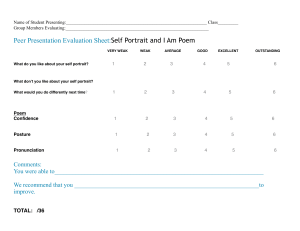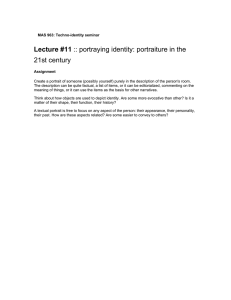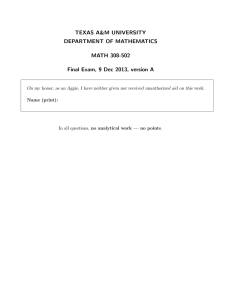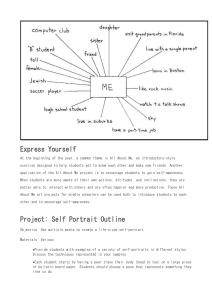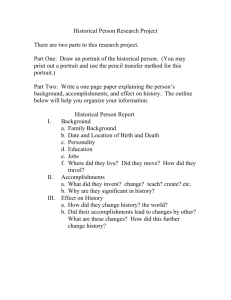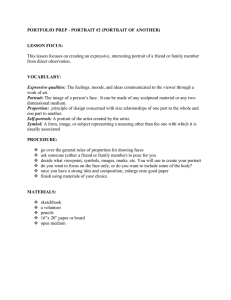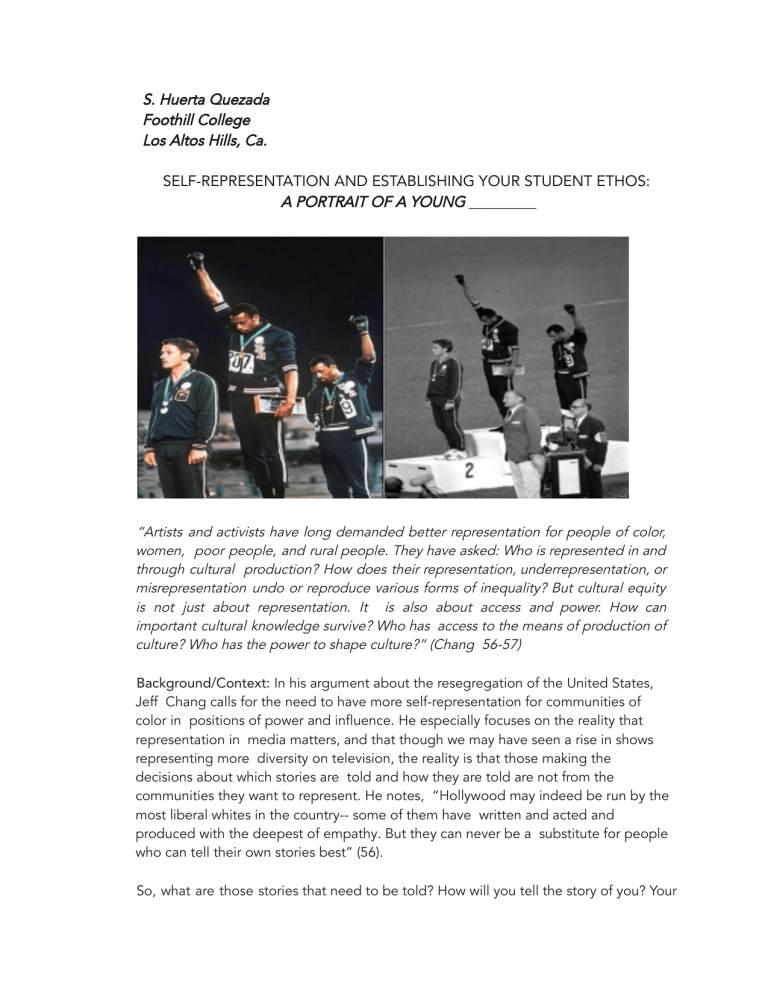
S. Huerta Quezada
Foothill College
Los Altos Hills, Ca.
SELF-REPRESENTATION AND ESTABLISHING YOUR STUDENT ETHOS:
A PORTRAIT OF A YOUNG _________
“Artists and activists have long demanded better representation for people of color,
women, poor people, and rural people. They have asked: Who is represented in and
through cultural production? How does their representation, underrepresentation, or
misrepresentation undo or reproduce various forms of inequality? But cultural equity
is not just about representation. It is also about access and power. How can
important cultural knowledge survive? Who has access to the means of production of
culture? Who has the power to shape culture?” (Chang 56-57)
Background/Context: In his argument about the resegregation of the United States,
Jeff Chang calls for the need to have more self-representation for communities of
color in positions of power and influence. He especially focuses on the reality that
representation in media matters, and that though we may have seen a rise in shows
representing more diversity on television, the reality is that those making the
decisions about which stories are told and how they are told are not from the
communities they want to represent. He notes, “Hollywood may indeed be run by the
most liberal whites in the country-- some of them have written and acted and
produced with the deepest of empathy. But they can never be a substitute for people
who can tell their own stories best” (56).
So, what are those stories that need to be told? How will you tell the story of you? Your
life? Your family? Your sense of home and justice? This project is an opportunity to help
you think about these important questions and tie them to your work as a Puente
student and scholar. Using what you have learned about the importance of a writer
establishing his/her ethos in a text, how can you establish your own ethos in your final
portfolio to give your audience a sense of who you are, what values you hold, and
what motivates you and shapes your current worldview.
The picture above is an image of Olympic winners, John Carlos and Tommie Smith,
two former San Jose State students who won the gold and bronze medals in Mexico
City in 1968 and threw up the Black Power fist to protest and give voice to the plight
of African Americans in the struggle for civil rights and basic human dignity. They
purposely selected their representation in this monumental moment: they wore black
socks to represent the poverty plaguing the Black community. Carlos unzipped up his
tracksuit to stand in solidarity with blue-collar workers in the US, and a necklace of
beads to represent the lives of people killed by lynching. Smith wore a black scarf
around his neck to represent Black pride. This representation of themselves was a
deliberate and informed message represented symbolically on a symbolic occasion.
Assignment Prompt: Take a Portrait or Selfie
Part I: In the spirit of this image, and to build on the ideas of Chang, Take a
meaningful self portrait, or “selfie,” in which you symbolically and artistically highlight
aspects of your identity that are most significant to you. Consider the discussions
we’ve had about cultural capital, personal journeys (like that of Sonia Sotomayor),
liberation, and the power of language and representation to help you decide on how
your portrait will look. This portrait will be published in your portfolio on your “About
Me” tab and you will be asked to share your portrait and to explain the significance of
the portrait choices you made when you present your portfolio to the class.
Steps in Creating Your Selfie/ Self-Portrait
Step 1- Reflect on Your Ethos: Think it through- who are you and how do you want to
represent yourself? Write a thoughtful personal narrative essay that somehow responds
to the first 2 questions below and at least 2 other questions of your choice. This
reflection will become a written testament of your ETHOS as a student. You will
publish this piece on your “about me” page. Please give your piece a title as well.
1. One of our essential questions for the quarter was to think about the role that
education plays in creating meaningful empathy. Write about one particular
reading, assignment, class discussion, writing project, or relationship with
another classmate that you feel has helped you develop empathy for another
perspective or experience different from your own.
2. How has your worldview changed or evolved this quarter as a result of the texts
we’ve read, the conversations we’ve had in class, or the relationships you have
built in the Puente Program these past two quarters?
3. When did you find yourself resisting particular ideas or readings? In what
ways did your personal background, value systems, and/or experiences
prevent you from wanting to read about a particular perspective?
i.
How did you address your resistance? What did you do to
become more open to other ideas? If you feel you did not
become more open, why did you make the choice to stand
firm in your resistance?
4. Explore the concept of motivation as it applies to both intrinsic and extrinsic
values and rewards. In what ways has your sense of motivation to be in school,
to continue on your educational path changed or been strengthened by your
examination of these intrinsic and extrinsic values and rewards?
5. What particular moment or experience, or person in your life motivates you to
continue on your educational path or to pursue a particular field of study?
Why?
6. What cultural capital do you possess and celebrate?
7. What particular moment or experience, or person in your life motivates you to
continue on your educational path or to pursue a particular field of study?
Why?
8. What particular narratives, assumptions, and/or “myths” about you, your
culture, your gender, your sexual orientation, or your identity in general, are
you trying to counter or challenge with your life’s decisions? Why do you feel
called to challenge these? Explain.
9. Which audience do you most want to reach with your work as a student? Who
do most want to impact? In what way do you want to make that impact and
why?
10. How has your academic literacy developed since starting in the Puente
Program? What do you see as the most important lessons you’ve learned
about yourself as a reader, or writer this year so far?
Step 2: Plan and Take Your Portrait- Using your ideas from the above reflection as a
guide, make deliberate choices about your portrait. Consider the following elements
when deciding how you will take your Selfie?Self Portrait
• Place: where will you take this photo of yourself? Why? What significance does
this place have for you today, your past, or for your future?
• Clothing: how do you want to present yourself in relation to your identity
characteristics? What articles of clothing or jewelry are important to help
you show who you are and how you want to present yourself to the world?
• Objects: what objects can you include in your portrait? What specific family,
cultural or spiritual objects hold a significance for you and can help
demonstrate what you value or how you see yourself as a student?
• Pose: how will you present yourself with your body language in this portrait and
how will that body language convey your identity?
• Lighting: how can you use light or specific filters to help you create an
emotion or connection to your portrait?
Step 3: Present your Selfie/Self Portrait to the class as a starting point for sharing your
portfolio We will begin the process of sharing your portfolio by conducting a gallery
walk of everyone’s selfie/self-portrait. Everyone will have an opportunity to react to one
another’s images. This will be the first part of our portfolio share-out week.

